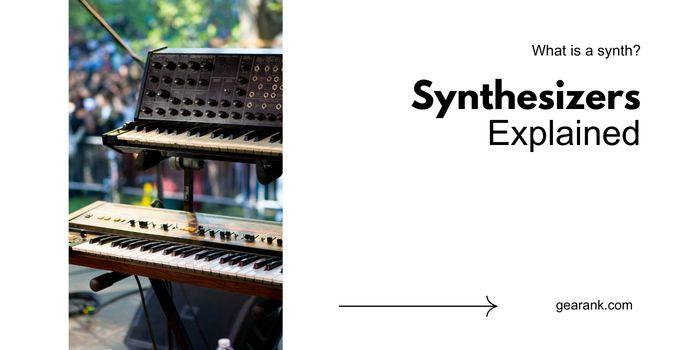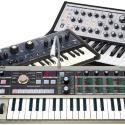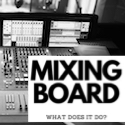What is a Synth? - The Ultimate Guide

Synthesizers are widely used in various styles of music. Yet even with their popularity, I often get asked this question: What is a synth?
This question often comes from curious students learning to play keys or piano. And if you are interested, this article is perfect for you.
What Makes Synths Unique?
For most of human history, music production was limited to mechanical instruments. This includes striking or vibrating a string (piano, guitar, and violin) or moving air through a shaft (woodwind and brass instruments).
The 20th Century brought on a new method of music creation. Using electronic devices to "synthesize" sounds for use in music. This family of instruments is known as synthesizers.
In this article, I'll make this complex instrument easier to understand. You'll appreciate how synthesizers work and where synth sounds come from. You'll also learn the main synth types, including analog synths, software synths, and digital synthesizers.
What is a Synthesizer?
Synths are electronic musical instruments. They use digital or analog processing that sound completely unique.
Synths were initially used to mimic the sound of existing acoustic instruments. But they made their mark when musicians made their own sounds using the synth's unique timbres.
These distinct sounds appealed to listeners and became a major component of many popular songs.
These days, synths are widely used in pop and electronic music.
Wondering what are 808s? Check out our guide for more insights.
History of Synth in Music
In 1935, the Hammond organ was released. It is one of the earliest electronic musical instrument that became widely popular. It helped pave the way for other electronic instruments to be considered legitimate tools for music production. It became one of the major precursors to modern synths.
The Hammond organ rode on the heels of earlier electronic instruments like the Dynamophone, which was released in 1897.
The Theremin, from 1928, is another noteworthy early electronic instrument. It had a contact-free interface, no buttons, and knobs. Instead, it uses electromagnetic fields controlled via hand gestures to generate sound.
All these developments led to the release of one of the earliest true synthesizers, the RCA Electronic Music Synthesizer Mark 1, in 1965. This programmable synth used vacuum tubes and patch cords to shape and produce sounds.
The 60s was also the era when the Moog Synthesizer came out, developed by its name sake Robert Moog. It was versatile and more expressive, which helped establish its reputation as one of the most popular classic synthesizers. And it is well revered to this day.
It generates sound via voltage-controlled oscillators and filters. It can produce pulse waves, saw waves, and square waves. It can also produce sine waves using a low-frequency oscillator.
Digital synthesizers grew in popularity in the 1970s before dominating the music industry in the 1980s. The Yahama DX7 digital synthesizer was at the forefront of this "new wave" of sounds used in mainstream songs.
What Role Do Synthesizers Play in Modern Music?
Today, synthesizers are still extremely popular and widely used in pop music. They can often be heard on stage at major concerts by big-name artists.
Gone are the days when analog synthesizers are limited to sine waves. Digital synths are now equipped with more tools for producing a wide range of sounds.
They can mimic familiar musical instrument sounds. And they can generate otherworldly pads and ambient sounds.
When you hear the question, "What is synth music?" you can think of songs layered with many synth parts.
And it's not a coincidence that many of these songs have dominated the charts, regardless of genre.
While pop and EDM use synths heavily, you can also hear synths in country, R&B, and rock music.
Many memorable instrumental melodies played in our heads were crafted and played through a synthesizer.
What are Analog Synthesizers?
You can find a wide range of different types of synthesizers on the market. But the most common are analog, digital, and software synths.
The Analog Synthesizer came first. It utilized analog circuitry and an electrical signal to produce musical sounds. It was prevalent in the 60s and 70s, used by bands from diverse genres like the Beatles and Pink Floyd.
Given the technological limitations of the time, most analog synths, including popular classic synths, used to be bulky and very expensive.
You still have to shell out quite a lot of money for an analog synthesizer today. But they are now a bit more compact and sleek.
Curious about arpeggiators? Dive into our detailed exploration.
What is a Digital Synthesizer?
The Digital Synthesizer gained popularity in the early 80s. These synths create sounds through digital signal processing, or DSP for short. They don't have an analog circuit, so they are much more portable and affordable.
The invention of the digital synthesizer allowed artists to craft their sounds at a more accessible price. They no longer need to pay big bucks for an analog synth or other traditional instruments.
One of the most influential digital synths is the Yamaha DX7, a big commercial success.
What is a Software Synthesizer?
Software synthesizers are where things are today. These virtual instruments can give you all the synth sounds and features without needing actual hardware.
Soft synths are easier to integrate into modern DAW recording workflows. DAW stands for Digital Audio Workstation - it is computer-based music production. All you need is a computer (or a tablet/phone) and a MIDI controller, and you're good to go.
Software synths used to be designed to replicate analog and digital models, but they now have innovative designs.
Much of the modern synth sounds we hear now are from soft synths. But some professionals still prefer the warmth and response of expensive analog hardware synths.
How Does A Synthesizer Produce Sound Waves?
Here I'll help you wrap your head around the basics of sound synthesis.
At the core of a sound synthesizer are electrical oscillators. These are circuits that produce oscillating electronic signals.
Much like how guitar strings vibrate and make sounds, so does these sound waveforms.
These signals form various types of sound wave shapes, including sine waves, sawtooth waves, square waves (often used for bass sounds), and triangle waves.
Combining, modulating, and tweaking these waveforms create the synthesizer sound variations we hear. Digital and software synthesizers have virtual oscillators that do the same thing.
The resulting sound pass through amplifiers, filters, envelope generators, and more. They are then manipulated to produce the variety of sounds you can get from synths.
Envelopes play a crucial role in shaping your sound. ADSR Envelope Stands for Attack Decay Sustain and Release. These four steps explain how the sound changes when a key is pressed and released.
Nowadays, electronic musicians use both analog and digital oscillators to create signals.
Filters are often used alongside synths. These are audio processors that filter out certain sounds. A low pass filter will allow low frequencies to pass through while blocking higher-frequency sounds. A high-pass filter will do the opposite.
Different Types Of Synthesis
To create a pitch, synthesizers don't just generate random waveforms. Instead, they layer the wave shape in an organized way. There are different types of synthesis. The most common ones are discussed below:
Additive And Subtractive Synthesis
Additive synthesis generates tones and timbres by layering different sine waves together. This type of synthesizer combines frequencies using different amplitudes. This process defines the character of the sound produced.
Additive synthesizers typically only create sine waves. This means users can only build sounds one harmonic at a time. The more oscillators they use, the better the final sound.
Subtractive synthesis differs as it starts with complex waveforms like square wave or sawtooth wave. It then deconstructs the audio signal using filters to attenuate specific parts of a signal.
The signals are then used to create a timbre. More often than not, subtractive synthesizers are linked to 60s and 70s music and analog synthesizers.
FM Synthesis
FM stands for Frequency Modulation. This type of synthesizer uses a second oscillator (modulator) to modulate the main oscillator (carrier).
The modulator signal alters the carrier frequency, resulting in new frequencies called sidebands. This produces complex harmonic-rich timbres for synthesizing a wide range of sounds. This is often used to add metallic or bell-like characteristics to the sound.
FM synthesis was discovered by John Chowning that discovered FM synthesis in the 60s. Yamaha then licensed and developed the technology.
They incorporated it in a prototype of the Yamaha GS-1. It was released to the public in 1980, becoming the first FM synthesis synthesizer.
Wavetable Synthesis
A wavetable synthesizer falls under the digital and software synth category. It utilizes digital audio samples (wavetables) as the core of the synthesized sound.
This lets you play with any sound source, like an instrument or voice. Once sampled, you can modify their pitch and harmonic content.
This is useful for making natural-sounding reproductions of other instruments. And it can also be used creatively to turn any sound sample into an instrument.
You can take the recorded waveform of any instrument or sound and turn it into a wavetable that can be played through any wavetable synth.
Modular Synthesis
The modular synthesizer is the biggest, flashiest, and most impressive among the types.
Modular synthesizers are towering units with numerous inputs, outputs, knobs, cables, and lights. But at the heart of these sound machines are synth modules, which can work as standalone units or as part of a single chain.
For example, some modular synths are filters, while others are oscillators. The term modular synthesizer often refers to hardware-based synthesis. But there are also virtual modular synthesizers that are software based.
With modular synthesis, you can experiment with different combinations of modular synths. This allows you to make a custom synth setup specific to what you want.
The downside is more hardware to maintain, bigger space requirements, and cost.
Should You Use A Hardware Synthesizer Or A Software Synthesizer
A considerable debate in the world of synthesizers' is whether it is better to use hardware-based synths or software-based synths.
Hardware and software synths have their quirks. Here we'll look at their advantages, so you can decide which suits you better.
Hardware Synthesizers
One of the biggest advantages of using a hardware synth is tactile control. Tweaking physical knobs gives you immediate control. Knobs are also more visually pleasing when performing.
Hardware synths also let you experiment and play with different connections. There are no easy presets, so you'll have to be more mindful of the parameters and details as you tweak.
This lets you master each component, which in turn, makes you a better sound designer.
Compared to feature packed soft synths, hardware synthesizers are modest musical instruments with limited features.
But these limitations prompt musicians to be creative and imaginative in producing sounds.
If you want to get your feet wet and learn the ins and outs of synthesizers, then this is the way to go.
Software Synthesizers
The main advantages of software synthesizers are portability, ease of use, and sound variety.
More often, they feature extra tools and settings. And they offer plenty of ready-made preset sounds that you can immediately use. The creative work is already done for you.
They also have extra features like modulation, vibrato effect, and more.
They are perfect for those who want to focus on music production and do not necessarily want to deal with the intricacies of a synthesizer.
Being software, it'll be as portable as your computer of choice. The downside is the musical instrument digital interface does not provide the same feel as hardware synth controls.
Software synthesizers are a lot easier to use too. The computer interface lets you easily control all your tools, settings, and sounds. This eliminates the need for multiple knobs, buttons, and cables.
Note that digital synthesizer keyboards give you some of the benefits of both types. They are a good in-between choice if you're not sure which side to pick between Synthesizer vs Keyboard options.
You can see our recommended best keyboard workstations here. Alternatively you may want to see out best synthesizer keyboard shortlist.
Frequently Asked Questions
Monophonic vs Polyphonic
Many classic synthesizers where monophonic, which means that they can only produce one note at a time. These types are often used to make single note lead synth lines. Monosynths rare also generally smaller and more affordable. Polyphonic synthesizers can play multiple notes at once, allowing for piano like chords and playability.
Does the Synthesizer Generate Sound Electronically?
Yes. Synths are electronic sound synthesizers. They produce and modify electronic signals to create sounds. These are not mechanical instruments, which makes them unique.
But they can mimic the sound of traditional instruments and are often used like a piano or organ.
What kind of sound does a Synthesizer Make?
Most synthesizers can produce a long list of sounds. The basic waveforms (sine, sawtooth, square, and triangle) serve as the fundamental frequency.
They can then be modified to create other sounds like pads and strings.
Other popular synth sounds include synth bass, lead, percussion, ambient soundscapes, and more.
There's also the magic of Frequency Modulation synthesis. It allows synths to sample and manipulate any sound source.
What makes Synthesizers unique?
What makes synthesizers unique is their ability to create complex sounds. Traditional musical instruments cannot generate them.
Even the simplest type of synthesizer, the basic sine wave generator, can create complex sounds by manipulating sine waves.
Final Thoughts
Now that you've made your way through this guide, you should have a much better understanding of what a synthesizer is.
A synthesizer is a complex musical tool that you can use to produce unique and impressive sounds. There is a wide range of different synthesizers to choose from. And they all have something interesting to offer.
If you found this What is a Synth article interesting, you may also want to read What is Hi-Fi.












